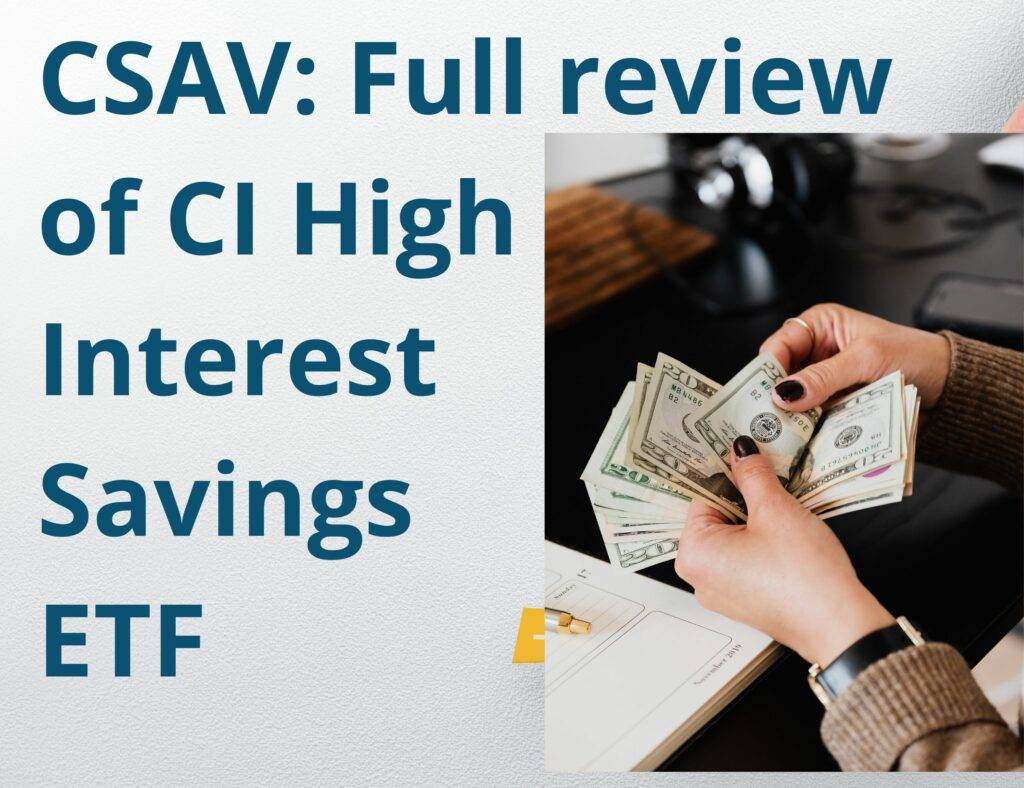One of the most popular high interest ETFs in Canada is CSAV CI High Interest Savings ETF. In this post, we will discuss CSAV’s objective, Fees and historical performance. We will also compare CSAV with similar ETFs.

What’s a High interest savings ETF?
High interest savings ETF are financial instruments designed to give investors a means to save capital while earning a competitive interest rate. Furthermore, they can provide investors with better returns than typical savings accounts or money market funds (while maintaining a high level of liquidity and safety, one of their main benefits).
High interest savings ETFs are often seen as relatively low-risk investments, in contrast to stocks or other types of investments.
CSAV investment objective
CSAV is relatively low risk investment suitable for investors looking for an alternative to high interest deposit accounts.
[stock_market_widget type=”card” template=”basic” color=”#5679FF” assets=”CSAV.TO” display_currency_symbol=”true” api=”yf”]
[stock_market_widget type=”chart” template=”line” color=”#5679FF” assets=”CSAV.TO” range=”1mo” interval=”1d” axes=”true” cursor=”true” range_selector=”true” display_currency_symbol=”true” api=”yf”]
Updated daily – XIU Stock
Historical performance CSAV vs similar ETFs
[stock_market_widget type=”table-quotes” template=”color-header-border” color=”#5679FF” assets=”CSAV.TO,CASH.TO,HISA.NE,PSA.TO,NSAV.NE” fields=”symbol,name,price,change_pct,net_assets” links=”{‘CSAV.TO’:{},’CASH.TO’:{},’HISA.NE’:{},’PSA.TO’:{},’NSAV.NE’:{}}” display_header=”true” display_chart=”false” display_currency_symbol=”true” pagination=”true” search=”false” rows_per_page=”20″ sort_field=”logo_name_symbol” sort_direction=”asc” alignment=”left” api=”yf”]
High interest savings ETF Canada – overview
- 10 Best Covered Call ETF Canada – High dividend yield
- Best Canadian dividend ETF – Top 16
- Best US Dividend ETFs in Canada
- Best Monthly Dividend ETF Canada
- Best ETFs in Canada 2023 (Canadian Index)
Forward dividend yield and Management fees
| Symbol | Dividend Yield | Fees |
|---|---|---|
| CSAV.TO | 4.78% | 0.15% |
| CASH.TO | 4.92% | na |
| HISA.NE | 4.90% | 0.15% |
| PSA.TO | 4.91% | 0.16% |
| NSAV.NE | 4.52% | 0.43% |
High interest savings ETF – Canada

You can click on the ticker of each ETF to visit the issuer’s website. Please note the dividend yield shown on the issuers’ websites corresponds to the forward dividend yield. The latter is a projection based on the last dividend paid.
The trailing dividend yield shown in the table above is the dividend yield calculated using the dividend paid in the last 350 days.
GIC vs High interest saving ETFs
| Investment Option | GIC | High-Interest Savings ETF |
|---|---|---|
| Type of Investment | Low-risk | Low to moderate risk |
| Return | Guaranteed fixed rate of return | Potentially higher rate of return |
| Term | Typically 1 to 5 years | No fixed term |
| Interest Rate | Typically higher than savings accounts | Varies depending on market conditions |
| Risk | Very low risk | Higher risk than GICs |
| Guarantee | Guaranteed by the issuing institution | No guarantee of return |
| Suitability | Suitable for risk-averse investors | Suitable for those seeking higher returns with moderate risk toleranc |
Difference between Forward and Trailing dividend yield
Dividend Yield (Forward) = (Most Recent Dividend * Dividend Frequency) / Price
Forward dividend yield and trailing dividend yield are both measures of a company’s dividend payout to its shareholders, but they differ in the time period used to calculate them.
Trailing dividend yield is calculated based on the dividends paid over the past 12 months, divided by the current stock price. It provides an indication of how much a company has paid out in dividends over the past year, relative to its current stock price.
Forward dividend yield, on the other hand, is calculated based on the expected dividends that will be paid out in the future, divided by the current stock price. It provides an indication of how much a company is expected to pay out in dividends over the next 12 months, relative to its current stock price.
The main difference between the two is that forward dividend yield is a projection of what is expected to happen in the future, whereas trailing dividend yield is based on actual historical data. As a result, forward dividend yield can be more speculative and less reliable than trailing dividend yield.
Investors may use both measures in combination to get a more complete picture of a company’s dividend payout.

